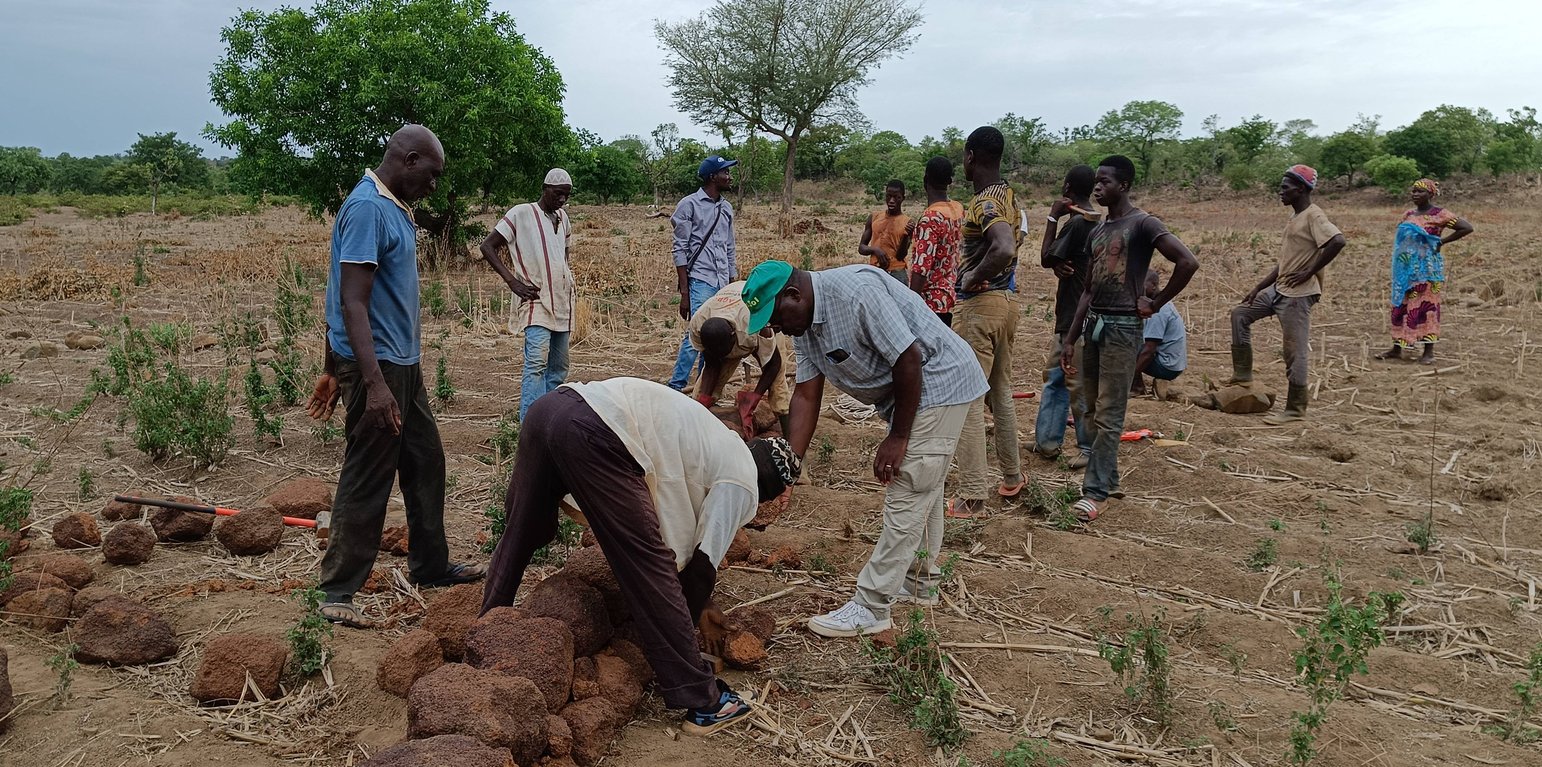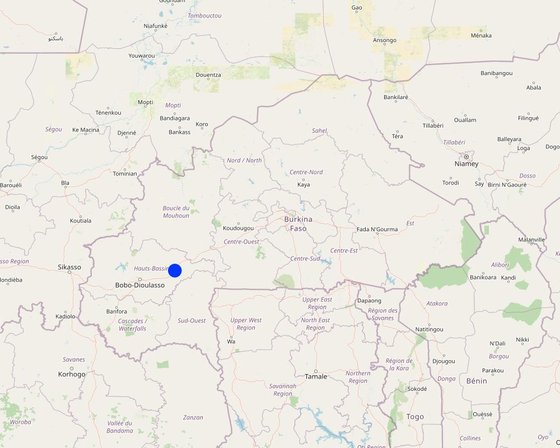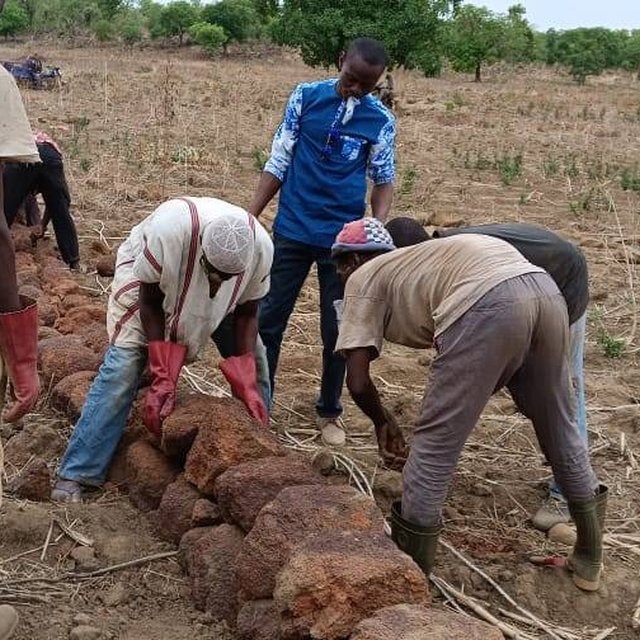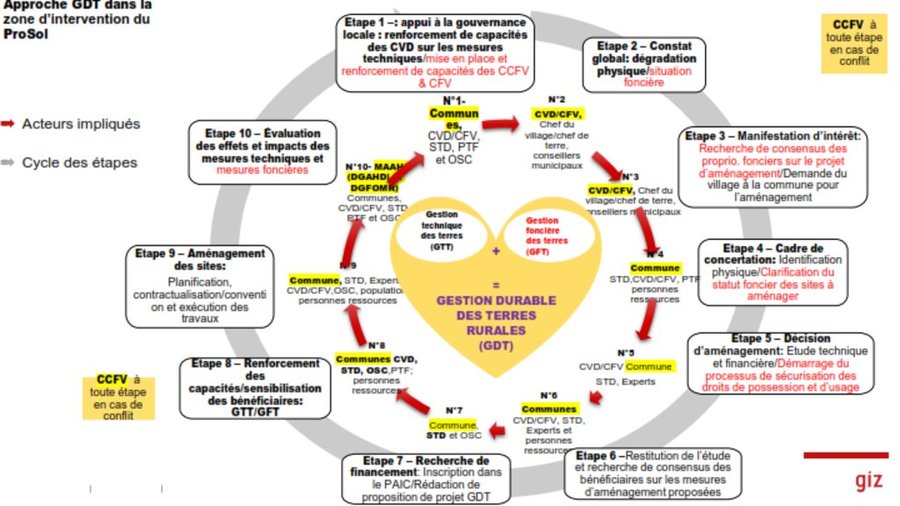



Implementing Sustainable Land Management (SLM) practices and addressing land-related issues through Village Development Councils (CDVs) is a participatory approach that empowers local stakeholders by emphasizing the importance of land tenure for the success and sustainability of SLM actions.
This approach aims to proactively anticipate land conflicts by clarifying land-related aspects before initiating any development. Its aim is to secure the consensus and agreement of beneficiaries regarding the adoption of SLM technologies promoted by ProSoil.
Implemented through a participatory and inclusive approach, various methods have been utilized, including capacity-building for farmers, mapping, consultation, information dissemination, and awareness-raising. The key stages of this approach are as follows:
1. Support for local governance processes;
2. Comprehensive assessment of the physical degradation/land tenure situation;
3. Expression of interest;
4. Consultation framework;
5. Development decision;
6. Feedback on the study and consensus-building among beneficiaries;
7. Fundraising;
8. Capacity-building/awareness-raising among beneficiaries;
9. Site development;
10. Assessment of the effects and impacts of the technical and land-related measures.
The main stakeholders involved in this strategy include municipalities (communes), CDVs, deconcentrated technical services (STDs), and local land authorities such as the land services, village land commissions, and village land conciliation commissions. ProSoil facilitated the establishment of SFRs, CFVs, and CCFVs in areas where they were previously non-existent. Once established, these entities, supported by communes, ProSoil, and civil society organizations, underwent training in various topics, including:
•the causes of soil degradation, anti-erosion measures, integrated soil fertility management;
•Act 034-2009/AN on rural land tenure and local conciliation mechanisms.
The key responsibilities of these stakeholders include raising awareness among land users about the multi-actor SLM approach, strengthening connections among SLM stakeholders, clarifying roles and responsibilities, jointly organizing SLM measures, integrating SLM measures into communal planning, and aligning land tenure with the "Land First" SLM approach. Additionally, these stakeholders play a role in providing a platform for exchange between local and national SLM stakeholders, building the capacity of stakeholders for collaborative SLM projects at the communal level, and capitalizing on a long-term SLM development approach.
Village Development Councils (CVDs) actively support the establishment of CFV/CCFVs, conduct inventories of landowning families, and are responsible for training, planning, executing development actions, and managing land issues. These responsibilities align with the provisions of Decree no. 2007-032/PRES/PM/MATD of January 22, 2007, on the organization, composition, and operation of village development councils. CVDs are accountable for the day-to-day management of village activities, including examining and providing written, reasoned opinions on development projects and programs, addressing issues affecting village development, and issuing detailed recommendations in areas such as preserving social peace, mobilizing the population around socio-economic initiatives, and protecting the environment.
Farmers express satisfaction with the participatory and inclusive nature of the process for implementing this approach. The approach fostered the involvement of all village stakeholders, leading to consensus and agreement on the implementation of SLM measures.

Location: Dankari (Commune of Koumbia), Hauts-Bassins Region, Tuy Province, Burkina Faso
Initiation date: 2018
Year of termination: n.a.
Type of Approach
| What stakeholders / implementing bodies were involved in the Approach? | Specify stakeholders | Describe roles of stakeholders |
| local land users/ local communities | Participation in the implementation process of the approach and consensus and agreement building among SLM stakeholders | |
| SLM specialists/ agricultural advisers | Their role is to coordinate the process of developing the approach using a participatory and inclusive approach. The Head of the Rural Land Service (SFR), who works in collaboration with the Village Development Council (CVD), the ProSoil land specialist and the Directorate-General for Land Tenure and Rural Organisation (DGFOMR), supported the process. | |
| NGO | Its role consisted of providing technical and financial support to those involved in implementing the approach. | |
| private sector | The private sector does not possess land ownership but plays a role as a service provider in the process. Primarily consisting of experts, their responsibility is to provide detailed insights in the mission report, offering summarized proposals for development techniques and assessing the land situation on the identified site. The involvement of the private sector occurs when consensus among stakeholders indicates the necessity to develop the identified site. |
Process for implementing the approach in the ProSol area of intervention

Decisions were taken by
Decisions were made based on
• Causes of soil degradation, anti-erosion measures and integrated soil fertility management;
• Act 034-2009/AN on rural land tenure and local conciliation mechanisms;
• Conflict management;
• The procedure for submitting a request to the Town Hall.
Subsidies are available for pickaxes, wheelbarrows, gloves, water levels, carts, forks, watering cans, shovels, hammers, and so on.
These are stones used in the construction of physical water and soil conservation structures.
These inputs are used in the revegetation of soil and water conservation and restoration structures, either by direct sowing or by transplanting.
Labour by land users was
The information and awareness-raising sessions conducted within the framework of this approach have enhanced stakeholder participation and commitment to the process.
The implementation of this approach started with farmers observing the deterioration of their soil capital, leading to expressions of interest in development projects.
Prior to its implementation, mass awareness-raising sessions on Sustainable Land Management (SLM) and land tenure management were conducted for beneficiary communities. In addition, the approach is implemented through Working Groups (WGs), which are essentially made up of land users who have been trained in setting up and maintaining the technologies. In the field, land users are responsible for implementing and maintaining SLM technologies. In view of these observations, it can be said that the Approach has helped land users to implement and maintain SLM technologies.
The decision to implement SLM measures promoted by ProSoil, is preceded by technical and financial studies involving various stakeholders such as CVDs, experts, STDs, land users, and ProSoil. This collaborative, consensus-driven, multi-stakeholder approach is underpinned by a cost-benefit and economic analysis of WSC/SDR measures. This study made it possible to carry out an economic analysis of the impact of the works in order to demonstrate that investing in WSC/SDR measures is not only economically profitable but also politically advantageous and socially essential. We can therefore conclude that the Approach has improved the coordination and implementation of SLM in a cost-effective manner.
Fundraising is one of the stages of the Approach. Once the technical report and budget have been validated, the commune begins the process of seeking funding. This involves establishing partnerships with projects, programs, industries (such as mining companies), and TFPs operating both at the municipal and national levels. ProSoil has implemented a three-fold support initiative for communes, aimed at facilitating their fundraising efforts: •Identifying existing available national and international funds dedicated to SLM; •Providing training to communes and private operators in crafting project proposals aligned with the frameworks of these identified funds, and developing SLM projects for submission to various funding sources. •Monitoring the process from proposal submission to the successful acquisition of SLM funding. To the extent SLM measures have been executed in the ProSoil intervention zone, it can be inferred that the Approach has facilitated/enhanced access to financial resources for the implementation of SLM.
One of the cornerstones of the Approach lies in capacity-building initiatives for farmers. To this end, farmers have been trained in a number of areas, including Technical Land Management (TLM), land tenure management, and the implementation and maintenance of SLM technologies promoted by ProSoil. These various capacity-building actions empower land users organized in working groups to implement and sustain the SLM measures promoted by ProSoil. Consequently, it can be concluded that the Approach has enhanced the knowledge and capabilities of land users in the implementation of SLM.
The implementation of SLM by the CVDs follows a consensual, multi-stakeholder approach. All stakeholders in this process benefit from capacity-building initiatives, including the upgrading of public and private service providers and the reinforcement of a system of relay farmer trainers. This leads to the conclusion that the approach has improved the knowledge and capacities of the other stakeholders involved.
The aim of this approach is to anticipate and mitigate land conflicts by clarifying land tenure aspects before any development takes place. While statistics on conflict reduction following the approach's implementation are unavailable, the implementation developments at the micro-basin level confirms this. This holds even more significance, as development becomes unattainable in the absence of consensus.
The approach is implemented at the micro-catchment level through a participatory and inclusive process, ensuring the involvement of all segments of society without discrimination. Consequently, it can be inferred that the approach has enhanced gender equality and empowered women and girls.
The approach is based on a participatory and inclusive methodology aiming to achieve agreement and consensus. Given the successful implementation of several SLM measures in the ProSoil intervention zone, it can be affirmed that the approach has addressed the land tenure and use rights issues hindering the implementation of the technologies.
This approach is a prerequisite for implementing SLM measures in the ProSoil intervention zone. Insights gathered from discussions with land users during the documentation of SLM technologies indicate a noticeable rise in agricultural yields subsequent to the implementation of SLM. Based on this information, we conclude that the Approach has led to improved food security and/or nutrition.
The objective of the Approach is to secure the consensus and agreement of beneficiaries for the implementation of technologies promoted by ProSoil. It is therefore not market-oriented, which leads us to assert that it has not improved access to markets.
Land users have not established a connection between the Approach and enhanced access to water and sanitation.
The Approach is designed to implement all the SWH/SRH technologies promoted by ProSoil. The implementation of these technologies is preceded by capacity building for land users. Additionally, during the documentation of certain SLM technologies, land users affirmed that the approach has enhanced their capacities to adapt to climate change, extremes, and disasters, and mitigate climate-related disasters.
The various technologies are implemented by working groups made up of land users. These groups assert that the application of these technologies has led to increased agricultural yields and, consequently, created opportunities for improved income.